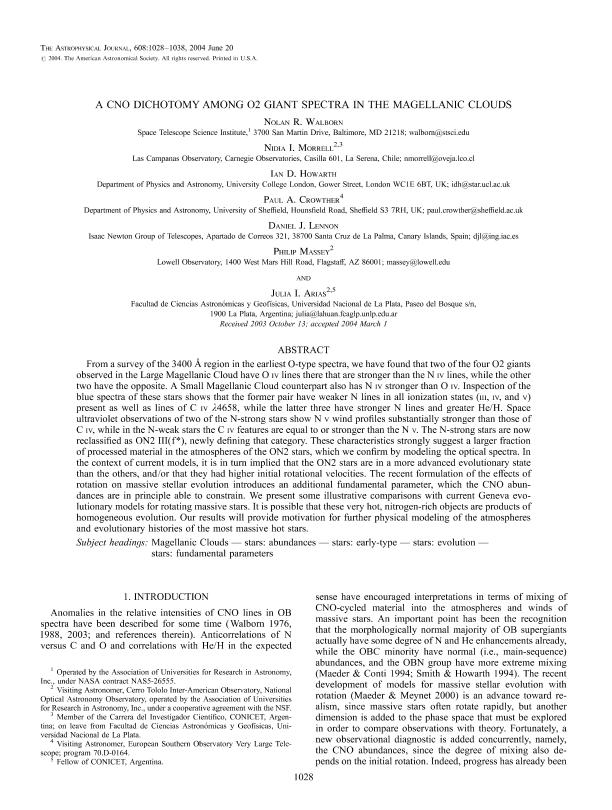Mostrar el registro sencillo del ítem
dc.contributor.author
Walborn, Nolan Revere

dc.contributor.author
Morrell, Nidia Irene

dc.contributor.author
Howarth, Ian D.
dc.contributor.author
Crowther, Paul A.
dc.contributor.author
Lennon, Daniel J.
dc.contributor.author
Massey, Philip
dc.contributor.author
Arias, Julia Ines

dc.date.available
2018-02-26T13:44:58Z
dc.date.issued
2004-06
dc.identifier.citation
Walborn, Nolan Revere; Morrell, Nidia Irene; Howarth, Ian D.; Crowther, Paul A.; Lennon, Daniel J.; et al.; A CNO Dichotomy among O2 Giant Spectra in the Magellanic Clouds; IOP Publishing; Astrophysical Journal; 608; 2; 6-2004; 1028-1038
dc.identifier.issn
0004-637X
dc.identifier.uri
http://hdl.handle.net/11336/37076
dc.description.abstract
From a survey of the 3400 Å region in the earliest O-type spectra, we have found that two of the four O2 giants observed in the Large Magellanic Cloud have O IV lines there that are stronger than the N IV lines, while the other two have the opposite. A Small Magellanic Cloud counterpart also has N IV stronger than O IV. Inspection of the blue spectra of these stars shows that the former pair have weaker N lines in all ionization states (III, IV, and V) present as well as lines of C IV λ4658, while the latter three have stronger N lines and greater He/H. Space ultraviolet observations of two of the N-strong stars show N V wind profiles substantially stronger than those of C IV, while in the N-weak stars the C IV features are equal to or stronger than the N V. The N-strong stars are now reclassified as ON2 III(f*), newly defining that category. These characteristics strongly suggest a larger fraction of processed material in the atmospheres of the ON2 stars, which we confirm by modeling the optical spectra. In the context of current models, it is in turn implied that the ON2 stars are in a more advanced evolutionary state than the others, and/or that they had higher initial rotational velocities. The recent formulation of the effects of rotation on massive stellar evolution introduces an additional fundamental parameter, which the CNO abundances are in principle able to constrain. We present some illustrative comparisons with current Geneva evolutionary models for rotating massive stars. It is possible that these very hot, nitrogen-rich objects are products of homogeneous evolution. Our results will provide motivation for further physical modeling of the atmospheres and evolutionary histories of the most massive hot stars.
dc.format
application/pdf
dc.language.iso
eng
dc.publisher
IOP Publishing

dc.rights
info:eu-repo/semantics/openAccess
dc.rights.uri
https://creativecommons.org/licenses/by-nc-sa/2.5/ar/
dc.subject
Magellanic Clouds
dc.subject
Abundances
dc.subject
Early Type Stars
dc.subject
Evolution of Stars
dc.subject
Fundamental Parameters
dc.subject.classification
Astronomía

dc.subject.classification
Ciencias Físicas

dc.subject.classification
CIENCIAS NATURALES Y EXACTAS

dc.title
A CNO Dichotomy among O2 Giant Spectra in the Magellanic Clouds
dc.type
info:eu-repo/semantics/article
dc.type
info:ar-repo/semantics/artículo
dc.type
info:eu-repo/semantics/publishedVersion
dc.date.updated
2018-02-19T16:55:04Z
dc.journal.volume
608
dc.journal.number
2
dc.journal.pagination
1028-1038
dc.journal.pais
Estados Unidos

dc.description.fil
Fil: Walborn, Nolan Revere. Space Telescope Science Institute; Estados Unidos
dc.description.fil
Fil: Morrell, Nidia Irene. Las campanas observatory; Chile
dc.description.fil
Fil: Howarth, Ian D.. University College London; Estados Unidos
dc.description.fil
Fil: Crowther, Paul A.. University of Sheffield; Reino Unido
dc.description.fil
Fil: Lennon, Daniel J.. Isaac Newton Group of Telescopes; España
dc.description.fil
Fil: Massey, Philip. Lowell Observatory; Estados Unidos
dc.description.fil
Fil: Arias, Julia Ines. Universidad Nacional de la Plata. Facultad de Ciencias Astronómicas y Geofísicas; Argentina
dc.journal.title
Astrophysical Journal

dc.relation.alternativeid
info:eu-repo/semantics/altIdentifier/doi/http://dx.doi.org/10.1086/420761
dc.relation.alternativeid
info:eu-repo/semantics/altIdentifier/url/http://iopscience.iop.org/article/10.1086/420761/meta
Archivos asociados
